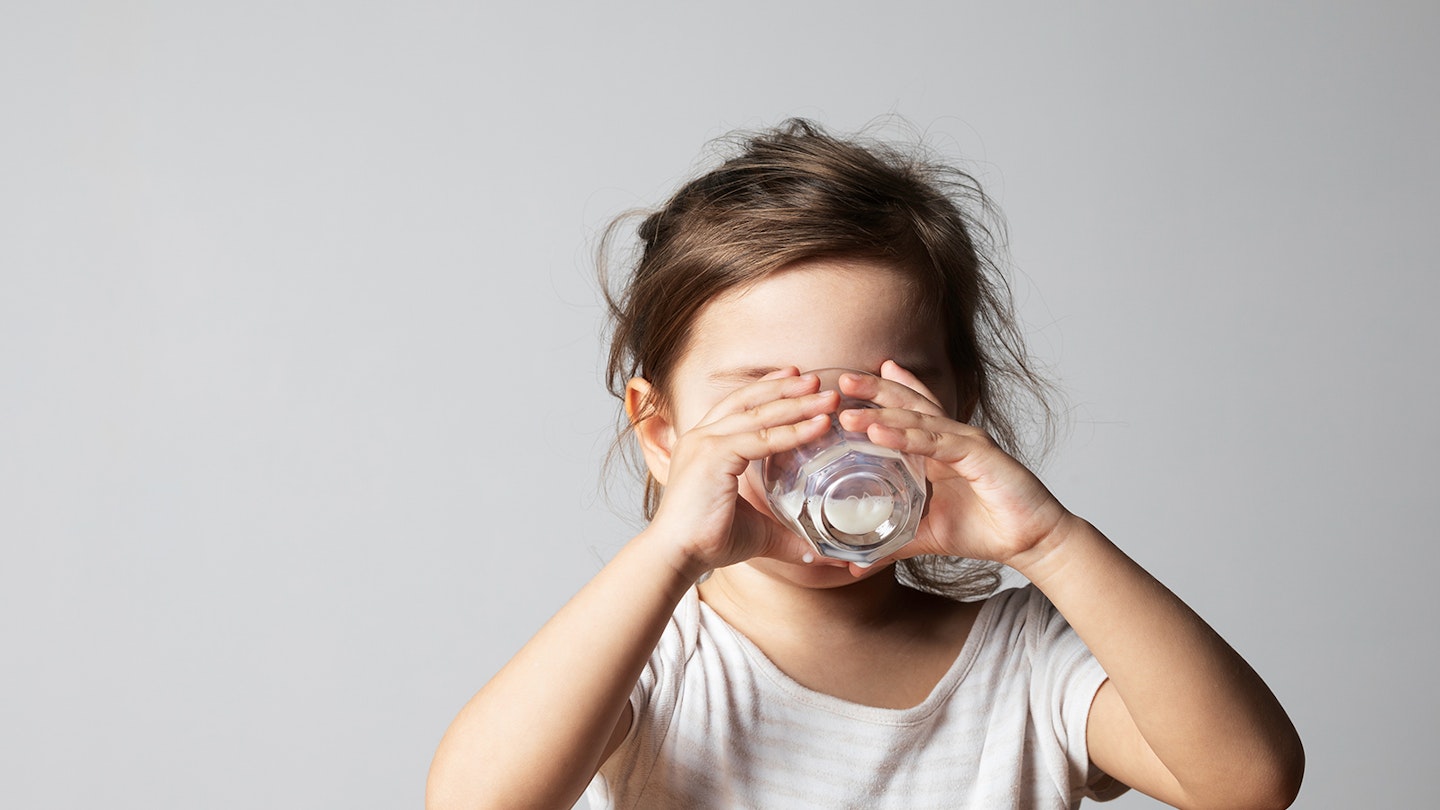When it comes to mum probs, you may think you’ve encountered them all, but then all of a sudden, one of your sprogs decides that they no longer want to drink milk — seemingly indefinitely.
So what are you supposed to do now? Babies drink milk. That’s just what they do, right? Well into toddlerhood and childhood, giving kids a nice tall glass (or two) of milk a day is a reassuring way for parents to feel content that their child is getting all the necessary vitamins they need for healthy bones, so that they’ll grow up to be big and strong. But what if, let’s say, your child doesn’t like to drink milk?
Before resorting to bribery, force-feeding, or concluding that you’ve failed as a parent, we’ve got a little lesser-known nugget of information to share with you, that may just lift a huge burden off your shoulders. Are you ready? Here goes: It’s OK if your toddler doesn’t want to drink milk — and get this; they don’t have to!*Audible gasps*
A child does, however, need to be receiving the imperative nutrients that milk can provide. The good news for parents of non-milk drinkers is that milk is not the only way these vitamins can be acquired. There are solutions to this problem that don’t include pleading, trickery, deception, or soy milk, and we break it all down for you below. Hold on to your hats because we’re about to get technical.
Related:Drinks you can give your toddler
Why does a baby need milk?

For the first year of a child’s life, especially the first six months when the baby hasn’t yet started solids, milk is the best — and only — way for them to get the vital nutrients to maintain their health and help them grow. Milk provides:
-
Calcium (bone and teeth maintenance, bone growth, proper muscle and metabolic function, normal neurotransmission)
-
Protein (bone and muscle maintenance and growth)
-
Fat (energy)
-
Vitamin A (vision, gene expression, immune system)
-
Vitamin B1, B2, B3, B5, B6, B12 (energy, metabolism, skin, nervous system, vision, iron, blood cell maintenance, fatigue reduction, immune system, normal psychological function)
-
Vitamin D (blood calcium maintenance, phosphorus balance, calcium metabolism)
-
Iodine (growth, energy, metabolism, skin, nervous system, cognitive function, thyroid regulation)
-
Potassium (nervous system, normal blood pressure, muscle function)
-
Phosphorus (growth and development of bone, tooth maintenance, cell membranes, energy and metabolism)
-
Magnesium (bone metabolism)
-
Folate (metabolism of proteins, nucleic acids, blood functions)
-
Selenium (oxidative stress response, electron transport, regulation of thyroid hormone)
-
Zinc (gene regulation)
How much milk does my child need per day?

In order to get all the above-mentioned nutrients, here’s how muchmilk your child should be getting per day after the age of six months, once they are fully on solids:
-
6-12 months: 500-600ml of breast milk or formula
-
1-3 years: 350ml breast milk, formula, or cow’s/goat’s/sheep’s milk
My child simply refuses to drink milk. Help!

Don’t panic; there are other ways for your child to get the necessary supplements that they would usually get from milk… without actually drinking milk! Although milk has an impressive array of health benefits, milk aloneisn’t the only source of all of these goodies.
Amy Lanou,a professor of nutrition at the University of North Carolina at Asheville, in an interview with Live Science, said that, after they are weanedfrom breast milk (or formula), children don’t really need milk, adding that most people in the world do not drink milk and yet still get adequate nutrition.
How can my toddler get their daily calcium and vitamin intake if they won’t drink milk?

At six months of age, when a baby has been weaned onto solids, if they start rejecting milk, you don’t have to worry; as long as they are getting all the above vitamins and minerals from other sources... And here’s where you can find them:
-
Calcium: broccoli, cabbage, okra, soya beans, tofu, nuts, baked goods with fortified flour, drinks fortified with calcium
-
Protein: meat, poultry, fish, yoghurt, cheese, butter, seeds, nuts, beans, legumes, soy products, tofu,
-
Fat: avocado, chia seeds, flax seeds, eggs, fish, nuts and nut butter, olives and olive oil, tofu, cheese, yoghurt, chocolate, coconuts
-
Vitamin A: cheese, eggs, oily fish, yoghurt, liver, spinach, carrots, sweet potatoes, red peppers, mango, papaya, apricot
-
Vitamin B1 (Thiamin): peas, fruit (fresh and dried), eggs, wholegrain bread, fortified cereal, liver
-
Vitamin B2 (Riboflavin): eggs, rice, fortified cereal
-
Vitamin B3 (Niacin): meat, fish, wheat flour, eggs
-
Vitamin B5: egg yolk, broccoli, yeast, peanuts, fish, shellfish, chicken, yoghurt, sweet potatoes, legumes, avocado, mushrooms
-
Vitamin B6: pork, poultry, fish, bread, wholegrain cereal, oatmeal, brown rice, eggs, vegetables, soya beans, peanuts, potatoes, fortified cereal
-
Vitamin B12: meat, salmon, cod, cheese, eggs, fortified cereal
-
Vitamin D: oily fish, red meat, and egg yolks
-
Iodine: fish, shellfish, cereals, grains
-
Potassium: bananas, broccoli, parsnips, Brussels sprouts, pulses, nuts, seeds, fish, beef, chicken, turkey
-
Phosphorus: red meat, cheese, fish, poultry, bread, brown rice, oats
-
Magnesium: spinach and other leafy vegetables, nuts, brown rice, whole grain bread, fish, meat, cheese
-
Folate: legumes, asparagus, eggs, leafy greens, beetroot, broccoli, Brussels sprouts
-
Selenium: brazil nuts, fish, meat, eggs
-
Zinc: meat, shellfish, cheese, bread, cereal
But… are we sure that they’re getting adequate calcium for their growing bones?
The main thing most parents are concerned about when it comes to their children drinking milk is the calcium required for their developing bones. The National Institutes of Health’s guide to how much calcium a child should be getting every day suggests:
-
Up to 6 months: 200 mg
-
6–12 months: 260 mg
-
1–3 years: 700 mg
-
4–8 years: 1,000 mg
To put it into context, here are a few examples of where else your child could get this amount of calcium:
-
237ml (one cup) cow’s milk = 276–352 mg calcium
-
2 tablespoons poppy seeds = 252mg calcium
-
28g parmesan cheese = 331mg calcium
-
127g wing beans = 244mg calcium
-
190g greens = 266mg calcium
-
126g tofu = 861mg calcium
Milk is, without a doubt, not the only option when it comes to calcium. Equally as important at calcium intake, however, is the amount of exercise a child is getting. "The best way for kids to take good care of bones is to go outside and play," continues Lanou.
3 ways your child can get what they need without drinking milk

There are three main ways to ensure your milk-rejecting offspring is getting their RDA of all the nutrients that milk can provide.
1) A varied diet: We’ve already established above which foods contain the same nutrients as milk; what’s left now is to add them to the shopping list and start incorporating them into your child’s diet. If you’re stuck on ideas, we’ve got some delicious and healthy recipes for babies and toddlersto get the ball rolling.
2) Get creative with milk: If the idea of your child going completely milk-free freaks you out a bit, you could start to get creative with the ways you offer it to them. Unless your child is lactose-intolerant or has an adverse reaction to dairy, smaller quantities of milk can be added to many daily dishes, eliminating the need for them to down a whole glass of milk, which they deem to be totally yucky. If you’ve tried all the different types of milk, and adding chocolate powder or honey (only if child is over two) and they still want none of it, why not try incorporating milk into other foods, such as:
-
Omelette: Whisk the eggs with milk before frying for a light and fluffy omelette your child is sure to love.
-
Soups: Many delicious soups have a milk base.
-
Smoothies: With their favourite fruit, i.e. banana and strawberry, getting them to ingest milk may not be a problem if it’s in the form of a smoothie.
-
Mac ‘n’ cheese: A notorious kid-friendly dish made with milk.
-
Dessert: Not many children will say no to a sweet course, so why not try some milk-based yummies such as mousse, crème caramel, Panna Cotta, and even some cakes and biscuit recipes that have milk as a main ingredient. You can even make ice cream!
-
Porridge: Porridge oats or cereal powders are a great way to get milk into a child.
3) Other dairy products: We’ve saved the best for last; by far the easiest way of replacing milk is to add other dairy products, like cheese, yoghurt, and butter, to your child’s meals. Just 43.7g of cheese (for reference, one little Babybel is 20g) or 218.7g (a typical children’s yoghurt is 125g) isequal to 350ml of milk — the recommended daily amount of milk required by 1-3-year-olds). Adding butter or cream cheese to foods is another great way to get that dairy in.
For a milk-snubbing little human, an omelette with a splash of milk, a cheese sandwich (heavy on the butter), and a yoghurt pot should be all that’s required to keep your mind at ease on the milk front.
Now read:
